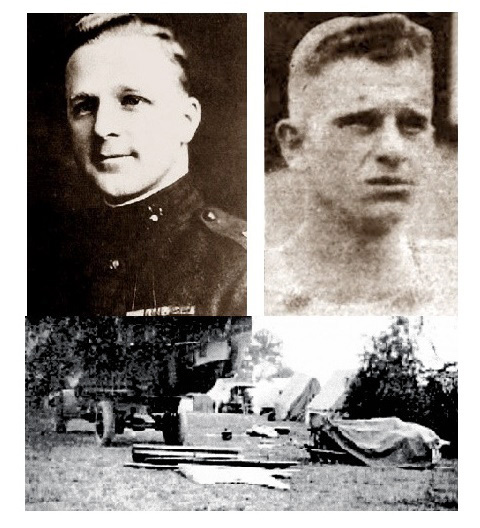The Fatal Crash of #6157
Richard D. L. Fulton
Based in part on The Last to Fall: The 1922 March, Battles, & Deaths of U.S. Marines at Gettysburg by Richard D. L. Fulton and James Rada, Jr.
The year was 1922, four years after the end of the First World War, when more than 5,000 Marines—along with all the equipage of war (tanks, machine guns, artillery, etc.)—descended upon Gettysburg, following their week-long trek from Quantico, Virginia, to the historic Civil War battlefield of 1863 for their annual summer maneuvers, combined with their public reenactments of Pickett’s Charge.
The column left Quantico on June 19 and arrived on the Gettysburg Battlefield on June 26, having camped along their march in the several communities, the last of which was in Thurmont. On June 26, the column marched out of Thurmont, proceeded through Emmitsburg, and pushed forward for Gettysburg.
Along their route on the “the long march,” squadrons of post-World War I bi-wing dive-bombers and scout-planes circled overhead to “protect” the column and their supplies (the march itself was conducted as if being in enemy country from Quantico to Thurmont).
One of those five-plane aerial squadrons had been captained by a highly decorated WWI hero, Captain George Wallis Hamilton, who had distinguished himself at the Battle of Belleau Wood in France by his fighting in the Marine infantry. Riding along as passenger in Hamilton’s two-seater de Havilland DH-4B (#6157) was Gunnery Sergeant George Russell Martin.
Hamilton’s squadron was scheduled to have the honor of leading the Marines onto the Gettysburg Battlefield. On June 26, Hamilton’s squadron left at 12:30 p.m. and headed-out to rendezvous with, and escort, the Marine column as it left Thurmont, his squadron flying overhead as they marched through Emmitsburg on their trek to Gettysburg.
Nothing unusual was noticed about Hamilton’s plane as he escorted the Marine column toward the battlefield, but as the squad circled the field preparing to land on an impromptu airfield that the Marines had created on the Codori farm (the main encampment site for their maneuvers and reenactments), his plane appeared to be developing problems.
According to the Record of Proceedings of the (Marine) Board of Investigations (held on July 2), “That (Hamilton’s) DH-4B was under perfect control from Quantico, Virginia, to Gettysburg, Pennsylvania).”
But as the captain’s squadron broke formation to begin landing, the “DH-4B airplane #6157 went into a tailspin from a left turn from which it did not recover and crashed to the ground,” according to Record of Proceedings.
The crash occurred in the area of Johns Avenue and Culp Street, just missing a carnival that had been set up along Steinwehr Avenue, and was located very closely to the front yard of the John’s Farmhouse.
Hamilton was found deceased in the wreckage, but Martin was still alive. He was transported to the Warren Hospital (Gettysburg Hospital) where he expired a short time later. Because both were engaged in Marine activities at the time of the crash, they then both became the last line-of-duty deaths to have taken place on the old Civil War battlefield since 1863.
The (Marine) Board of Investigations was never able to determine the cause of the crash, stating, “The board is unable to determine the responsibility for the crash of (Hamilton’s) airplane… and is not able to attach any blame of culpability to any person or persons in the Naval service.”
The motor of Hamilton’s plane was salvaged, and the wood and canvas burned. The remaining metal was sold as scrap and, after having been loaded onto a truck, was halted at the Town Square to allow locals to take pieces for souvenirs. Hamilton was subsequently interred in the Arlington Cemetery, while Marin’s body was sent back to his home in Buffalo and buried there.
Today, the site of the crash is marked by a memorial wayside dedicated to the two aviators who perished on June 26. The memorial was created by a consortium of area residents, members of the Gettysburg and Emmitsburg Marine Corps Leagues, and the Gettysburg Heritage Center.
The memorial wayside dedication was held on June 26, 2018. Members of the U.S. Marine Corps Historical Company, Marines from Fort Meade, and a Marine bugler from Marine Base Quantico participated in the dedication ceremony.

(Top, left) Captain George Wallis Hamilton and Gunnery Sergeant George Russell Martin (top, right); (Bottom) Removal of the DH-4B wreckage (note carnival tents in background).
Source (Hamilton and Martin pictures): Buffalo Evening News, June 27, 1922
Source (wreckage): Leatherneck, April 1, 2014

From the June 26, 2018, Hamilton-Martin Memorial Wayside dedication: Participating Marine units and Naval officer pose in front of the John’s Farm House.

